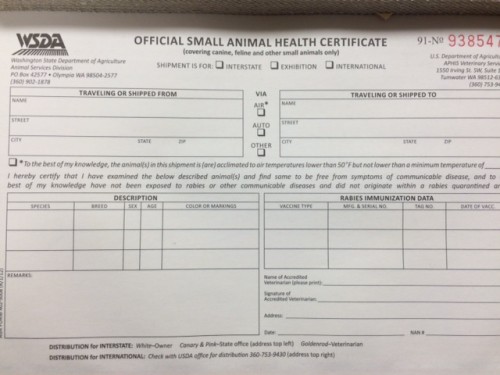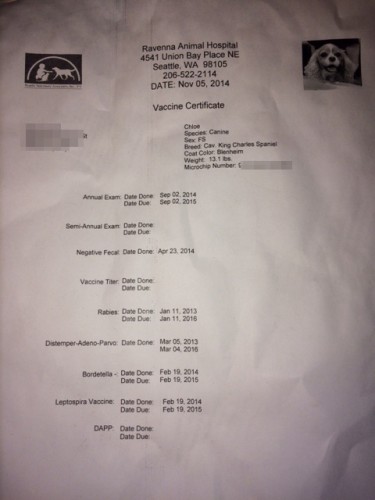Interstate health certificate, shot record, international health certificate, pet passport: Sorting out the documents
A couple of days ago I wrote a post about how Alaska Airlines has changed its pet travel policy to require a health certificate for travelers with in-cabin pets. That was newsworthy because for the past several years, no major U.S. airline other than Hawaiian had that policy. Health certificates are, and (essentially) always have been, required for crated pets traveling as baggage/cargo, but for in-cabin pets they were a thing of the past — so much so that there was confusion in Dog Jaunt Nation over what I meant by a “health certificate.” A flurry of posts on Dog Jaunt’s Facebook page later, it struck me that it’d be helpful to see what an interstate health certificate looks like, and make it clear that it’s a different beast than a shot record or the documentation you need to take your pet abroad.
Interstate health certificate
This post, though much edited, will tell you nearly all you need to know about interstate health certificates. What’s missing is a picture of the certificate (sometimes formally known as a “Certificate of Veterinary Inspection”). Washington state’s certificate is a half-page document that looks like this:

The different states’ forms vary in appearance, but they cover the same info
It’s signed by your veterinarian after she conducts a brief but thorough physical exam of your pet, and consults your pet’s vaccination records. Getting one requires making an appointment with your vet and, because it involves both tech and vet attention and time, a fairly substantial payment (typically around $50).
Once signed, an interstate health certificate lasts for 30 days; it’s typically required to be signed within 10 days of travel; and those two time periods are normally not a problem except when there’s an unexpected delay on the front end (consider getting your certificate shortly before you’re scheduled to depart) or you’ve planned a very long vacation (keep an eye on your certificate’s expiration date, and be prepared to get a new one, from a vet at your destination, for your return trip).
Shot record
Another document you can get from your vet is your pet’s shot record:

I’m not winning any awards for this picture, and the paper got drenched in today’s rain, but you get the idea
You’ll note that this document is labeled a “vaccine certificate,” and if your vet has a similar form, you might be misled by that word “certificate.” But as you can see, this is just a list of Chloe’s vaccinations and their current status.
It does not cost anything. Your vet’s front desk staff will print one for you on request (if you discover a need for one while you’re on the road, your vet will likely fax you a copy, but please note that that will only happen during your vet’s business hours).
A shot record is a useful object, and I always travel with the current version of Chloe’s, because you never know when it might be needed. Infrequently, a hotel will ask for it, and pet daycare facilities always do. It is not, however, an acceptable substitute for a health certificate, because it is not a statement signed by your veterinarian vouching for your pet’s health at a particular point in time. (And please note that an interstate health certificate would not address the needs of a daycare facility, since it focuses on rabies and doesn’t mention bordatella/kennel cough.)
International health certificate
When you’re preparing to travel abroad with your pet, you assemble a packet of documents required by the country you’re visiting. In this post, I included photos of the documents we gathered to take Chloe on our last trip to France (please note that the packet included a “Rabies Vaccination Certificate for the State of Washington,” which also includes the word “certificate” in its title and also does not qualify as an interstate health certificate!). This packet will look much the same for all EU countries, but other countries’ forms will vary a bit. [4/6/15 The form for a health certificate for pets traveling from the U.S. to the E.U. changed a few months ago — be sure to download and fill out the current form.]
I’ve given you advice on how to find the correct, current forms for the country you want to visit, and I won’t repeat that here. This post is just to show you that an international health certificate (ours was called a “Veterinary certificate to EU”) is a different creature than the interstate health certificate Alaska Airlines now requires. The EU certificate is bilingual (French & English) and five pages long, and here’s one [PDF] from a randomly-chosen non-EU country (Brazil) — as you’ll see, it’s also bilingual (Portuguese & English) and it’s three pages long.
International health certificates require an examination by your vet, and depending on your destination, your vet may also have to perform and record the results of additional procedures, like a rabies titration or a treatment against Echinococcus multilocularis. You’ll pay significantly more for your international paperwork than for an interstate health certificate.
Once signed, your international paperwork typically needs to be presented at your destination country within 10 days (but please do not take my word for it — that’s a crucial detail you’ll want to nail down for yourself). How long it lasts varies by country — our EU paperwork for Chloe was “valid for 10 days from the date of issue by the official veterinarian until the date of the checks at the EU travellers’ point of entry and for the purpose of further movements within the Union, for a total of 4 months from the date of issue of this certificate or until the date of expiry of the anti-rabies vaccination, whichever date is earlier,” while the Brazilian form states that it’s “valid for 60 (sixty) days from the date of issuance.”
What about those pet passports you’ve heard about? They are also for international travel, but, officially, they’re only meant for residents of the E.U. That said, we got one for Chloe when we were last in Paris, and several Dog Jaunt readers have done the same thing. The tech who handles our Seattle veterinarian’s international paperwork recently told me about a client of theirs who frequently travels to France, and uses an E.U. pet passport to do it [but see Audra’s very helpful cautionary comment, below]. Here’s what it looks like; as you’ll see, it covers the same info as the international paperwork you’d typically assemble. On our next trip to Europe, I plan to have our normal international paperwork in my back pocket, so to speak, and attempt using just Chloe’s E.U. pet passport (appropriately updated and signed by her U.S. vet) to get there, around, and back.
As you contemplate upcoming travel, think carefully about what documents you’ll need and their “good for” dates (you’ll want to keep a sharp eye on your dog’s rabies vaccination expiration date too). As an example, my frequent flyer miles are on United, so I could return to the U.S. using the same documents that accompanied Chloe into France (assuming that her rabies vaccination falls into the proper time window), and continue on my merry way to Seattle. But after December 4, travelers who arrive in the U.S. and transfer to an Alaska Airlines flight will need to provide an interstate-style health certificate signed and dated by a vet no more than 10 days earlier, if that’s the first Alaska flight in their itinerary — and what if they were on a two-week vacation? (You’d find a vet at your destination, and get them to examine your pup and fill out a form of certificate that would satisfy the local U.S. authorities, as personified by the Alaska Airlines ticketing or gate agent you encounter. Do-able, never fear, but you’ll need to think ahead.)
How I hope that Alaska Air remains a voice crying in the wilderness on this one — well, except for Hawaiian, but if I was a rabies-free island I’d be careful too. Let me know if I’ve left your questions unanswered. These documents are a tricky business!




